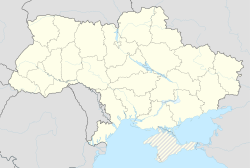Orikhiv
|
Orikhiv Оріхів |
|||
|---|---|---|---|
|
|||
| Coordinates: 47°34′10″N 35°46′40″E / 47.56944°N 35.77778°E | |||
|
Country Oblast Raion |
Orkhivskyi Raion |
||
| Founded | 1801 | ||
| Area | |||
| • Total | 10 km2 (4 sq mi) | ||
| Population (2013) | |||
| • Total | 15,281 | ||
| Postal code | 70500 | ||
| Area code(s) | +380 6141 | ||
| Climate | Dfa | ||
Orikhiv (Ukrainian: Оріхів; Russian: Орехов) is a city in Zaporizhia Oblast, Ukraine. It serves as the administrative center of Orikhiv Raion. Population: 15,281 (2013 est.).
Orikhiv was founded on about 1793 near the Konka River; it was incorporated in 1801. It is situated about 50 km (31.07 mi) southeast of Aleksandrovsk (today Zaporizhya), and almost the same distance north of the Molochna Kolonia (Milk Colony). In 1818 Orikhiv appeared to be a place where military personnel of the Czar was stationed; an officer from Orikhiv came out to finalize arrangements for the Czar's visit to Lindenau in May of that year. As early as 1836 a "Salt Road" (Tschumakemveg) connected Orikhiv with Perekop to the south, the road running through the Molochna Kolonia. This road was still shown on maps of 1852. In 1850 Orikhiv was within the boundaries of Taurida, near the northeast border of that province. When the railway was built connecting Aleksandrovsk to Berdyansk it went through Orikhiv, presumably helping the development of the city and giving an easy access to the port at Berdyansk.
The first Mennonites likely settled in Orikhiv as early as the 1830s. By 1852 there were two windmills in Orikhiv owned by Mennonites (Kornelius Ediger and Kornelius Heinrichs) as well as a treadmill and oil press operated by Aaron Wiens. In the 1860s a number of families moved from Schoenwiese of the Khortytsia Colony to Orikhiv. Among these was Johann Heinrich (Ivan Andreievitch) Janzen, who built two large steam-powered flour mills and encouraged other Mennonite businessmen to follow his example.
By 1874 the small Mennonite community, in cooperation with the equally small Lutheran group, had built a church and a school. Apparently the Mennonites and Lutherans had joint services in the church, but for major festivals the Mennonites tended to go to their home churches, for many this being Schoenwiese in the Chortitza Colony. They also went back to their home churches to allow the young people to meet prospective marriage partners.
...
Wikipedia



